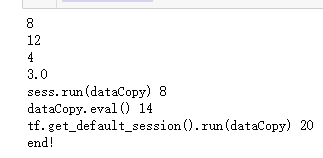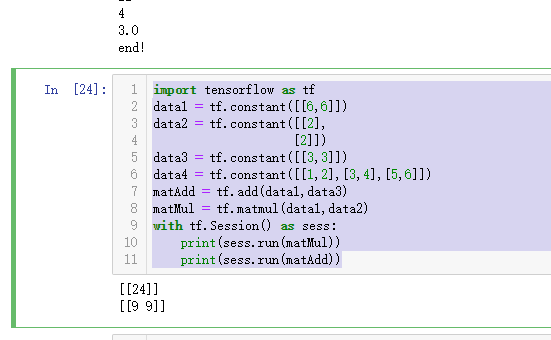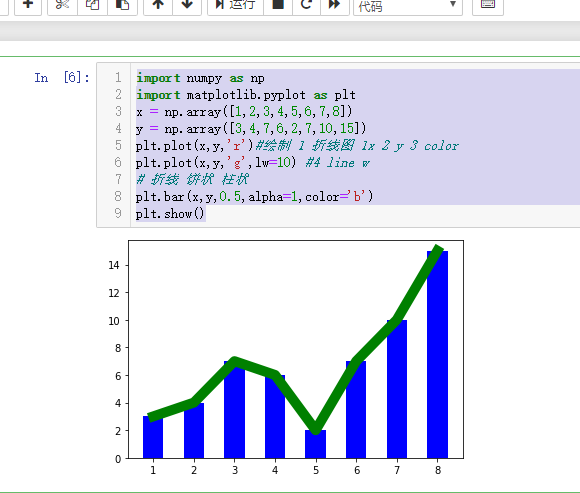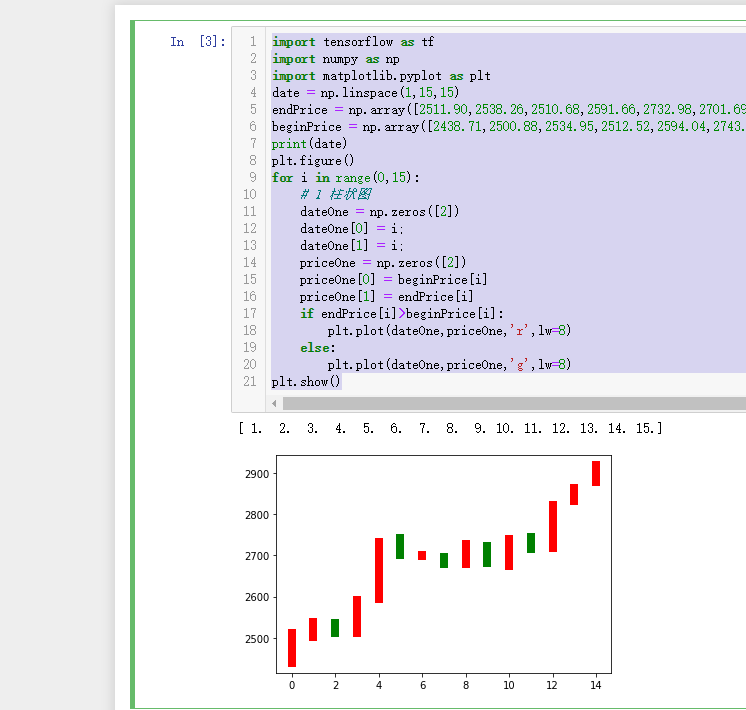一、常量的定义
import tensorflow as tf #类比 语法 api 原理 #基础数据类型 运算符 流程 字典 数组 data1 = tf.constant(2,dtype=tf.int32) data2 = tf.Variable(10,name='var') print(data1) print(data2) #shape 维度 const长度 shape维度 dtype 数据类型 sess = tf.Session() print(sess.run(data1)) init = tf.global_variables_initializer() sess.run(init) print(sess.run(data2))
必须通过session来操作对象
二、tensorflow运行实质
tensorflow运算实质是由 tensor + 计算图
tensor 数据
op operation 赋值,运算
graphs 数据操作的过程
session 是执行的核心
import tensorflow as tf #类比 语法 api 原理 #基础数据类型 运算符 流程 字典 数组 data1 = tf.constant(2,dtype=tf.int32) data2 = tf.Variable(10,name='var') print(data1) print(data2) #shape 维度 const长度 shape维度 dtype 数据类型 ''' sess = tf.Session() print(sess.run(data1)) init = tf.global_variables_initializer() sess.run(init) print(sess.run(data2)) ''' init = tf.global_variables_initializer() sess = tf.Session() with sess: sess.run(init) print(sess.run(data2))
四则运算:
import tensorflow as tf data1 = tf.constant(6) data2 = tf.Variable(2) dataAdd = tf.add(data1,data2) dataCopy = tf.assign(data2,dataAdd) #先把 6 和2进行计算 dataMul = tf.multiply(data1,data2) dataSub = tf.subtract(data1,data2) dataDiv = tf.divide(data1,data2) init = tf.global_variables_initializer() with tf.Session() as sess: sess.run(init) print(sess.run(dataAdd)) print(sess.run(dataMul)) print(sess.run(dataSub)) print(sess.run(dataDiv)) print('sess.run(dataCopy)',sess.run(dataCopy)) print('dataCopy.eval()',dataCopy.eval())#eval的用法与下行一样 print('tf.get_default_session().run(dataCopy)',tf.get_default_session().run(dataCopy)) print("end!")
运行结果:

3、矩阵
placehold 预定义变量
#placehold 预定义 import tensorflow as tf data1 = tf.placeholder(tf.float32) data2 = tf.placeholder(tf.float32) dataAdd = tf.add(data1,data2) with tf.session() as sess: print(sess.run(dataAdd,feed_dict=(data1:6,data2:2))) # 1 dataAdd 2 data (feed_dict = {1:6 2}) print('end')
基本操作
import tensorflow as tf data1 = tf.constant([[6,6]]) data2 = tf.constant([[2], [2]]) data3 = tf.constant([[3,3]]) data4 = tf.constant([[1,2],[3,4],[5,6]]) print(data4.shape)#打印维度 with tf.Session() as sess: print(sess.run(data4))#打印整体内容 print(sess.run(data4[0]))#打印某一行 print(sess.run(data4[:,1]))#打印某一列 print(sess.run(data4[1,1]))#打印第一行第一列
基本操作
import tensorflow as tf data1 = tf.constant([[6,6]]) data2 = tf.constant([[2], [2]]) data3 = tf.constant([[3,3]]) data4 = tf.constant([[1,2],[3,4],[5,6]]) matAdd = tf.add(data1,data3) matMul = tf.matmul(data1,data2) with tf.Session() as sess: print(sess.run(matMul)) print(sess.run(matAdd))

import tensorflow as tf mat0 = tf.constant([[0,0,0],[0,0,0]]) mat1 = tf.zeros([2,3]) mat2 = tf.ones([3,2]) mat3 = tf.fill([2,3],15) with tf.Session() as sess: #print(sess.run(mat0)) print(sess.run(mat1)) print(sess.run(mat2)) print(sess.run(mat3))
运行结果:

import tensorflow as tf mat1 = tf.constant([[2],[3],[4]]) mat2 = tf.zeros_like(mat1) mat3 = tf.linspace(0.0,2.0,11) mat4 = tf.random_uniform([2,3],-1,2) with tf.Session() as sess: print(sess.run(mat2)) print(sess.run(mat3)) print(sess.run(mat4))

四、Numpy的使用
#CRUD import numpy as np data1 = np.array([1,2,3,4,5]) print(data1) data2 = np.array([[1,2], [3,4]]) print(data2) #维度 print(data1.shape,data2.shape) #zero ones 单位矩阵 print(np.zeros([2,3]),np.ones([2,2])) #改查 data2[1,0] = 5 print(data2) print(data2[1,1]) #加减乘除 data3 = np.ones([2,3]) print(data3*2) print(data3/3) print(data3+2) print(data3-3) #矩阵的加法和乘法 data4 = np.array([[1,2,3],[4,5,6]]) print(data3+data4) #
五、matplotlib的使用
绘制折线图
import numpy as np import matplotlib.pyplot as plt x = np.array([1,2,3,4,5,6,7,8]) y = np.array([3,4,7,6,2,7,10,15]) plt.plot(x,y,'r')#绘制 1 折线图 1x 2 y 3 color

柱状图:
import numpy as np import matplotlib.pyplot as plt x = np.array([1,2,3,4,5,6,7,8]) y = np.array([3,4,7,6,2,7,10,15]) plt.plot(x,y,'r')#绘制 1 折线图 1x 2 y 3 color plt.plot(x,y,'g',lw=10) #4 line w # 折线 饼状 柱状 plt.bar(x,y,0.5,alpha=1,color='b') plt.show()

神经网络逼近股票收盘价格
首先绘制K线
import tensorflow as tf import numpy as np import matplotlib.pyplot as plt date = np.linspace(1,15,15) endPrice = np.array([2511.90,2538.26,2510.68,2591.66,2732.98,2701.69,2701.29,2678.67,2726.50,2681.50,2739.17,2715.07,2823.58,2864.90,2919.08]) beginPrice = np.array([2438.71,2500.88,2534.95,2512.52,2594.04,2743.26,2697.47,2695.24,2678.23,2722.13,2674.93,2744.13,2717.46,2832.73,2877.40]) print(date) plt.figure() for i in range(0,15): # 1 柱状图 dateOne = np.zeros([2]) dateOne[0] = i; dateOne[1] = i; priceOne = np.zeros([2]) priceOne[0] = beginPrice[i] priceOne[1] = endPrice[i] if endPrice[i]>beginPrice[i]: plt.plot(dateOne,priceOne,'r',lw=8) else: plt.plot(dateOne,priceOne,'g',lw=8) plt.show()

实现人工神经网络:
分为三层:
1、输入层
2、中间层(隐藏层)
3、输出层
在这里面 输入矩阵为15 x 1
隐藏层矩阵 1x10的矩阵
输出层 输出矩阵
15 x 1
实现的功能:
通过天数输入 输出每天对应的股价
隐藏层
A*W1+b1 = B
B*w2+b2 = C
A:输入层 B:隐藏层 C:输出层 W1 1x10 B1 1x10偏移矩阵
代码如下:
# layer1:激励函数+乘加运算 import tensorflow as tf import numpy as np import matplotlib.pyplot as plt date = np.linspace(1,15,15) endPrice = np.array([2511.90,2538.26,2510.68,2591.66,2732.98,2701.69,2701.29,2678.67,2726.50,2681.50,2739.17,2715.07,2823.58,2864.90,2919.08] ) beginPrice = np.array([2438.71,2500.88,2534.95,2512.52,2594.04,2743.26,2697.47,2695.24,2678.23,2722.13,2674.93,2744.13,2717.46,2832.73,2877.40]) print(date) plt.figure() for i in range(0,15): # 1 柱状图 dateOne = np.zeros([2]) dateOne[0] = i; dateOne[1] = i; priceOne = np.zeros([2]) priceOne[0] = beginPrice[i] priceOne[1] = endPrice[i] if endPrice[i]>beginPrice[i]: plt.plot(dateOne,priceOne,'r',lw=8) else: plt.plot(dateOne,priceOne,'g',lw=8) #plt.show() # A(15x1)*w1(1x10)+b1(1*10) = B(15x10) # B(15x10)*w2(10x1)+b2(15x1) = C(15x1) # 1 A B C dateNormal = np.zeros([15,1]) priceNormal = np.zeros([15,1]) for i in range(0,15): dateNormal[i,0] = i/14.0; priceNormal[i,0] = endPrice[i]/3000.0; x = tf.placeholder(tf.float32,[None,1]) y = tf.placeholder(tf.float32,[None,1]) # B w1 = tf.Variable(tf.random_uniform([1,10],0,1)) b1 = tf.Variable(tf.zeros([1,10])) wb1 = tf.matmul(x,w1)+b1 layer1 = tf.nn.relu(wb1) # 激励函数 # C w2 = tf.Variable(tf.random_uniform([10,1],0,1)) b2 = tf.Variable(tf.zeros([15,1])) wb2 = tf.matmul(layer1,w2)+b2 layer2 = tf.nn.relu(wb2) loss = tf.reduce_mean(tf.square(y-layer2))#y 真实 layer2 计算 train_step = tf.train.GradientDescentOptimizer(0.1).minimize(loss) with tf.Session() as sess: sess.run(tf.global_variables_initializer()) for i in range(0,10000): sess.run(train_step,feed_dict={x:dateNormal,y:priceNormal}) # w1w2 b1b2 A + wb -->layer2 pred = sess.run(layer2,feed_dict={x:dateNormal}) predPrice = np.zeros([15,1]) for i in range(0,15): predPrice[i,0]=(pred*3000)[i,0] plt.plot(date,predPrice,'b',lw=1) plt.show()

预计结果基本上吻合